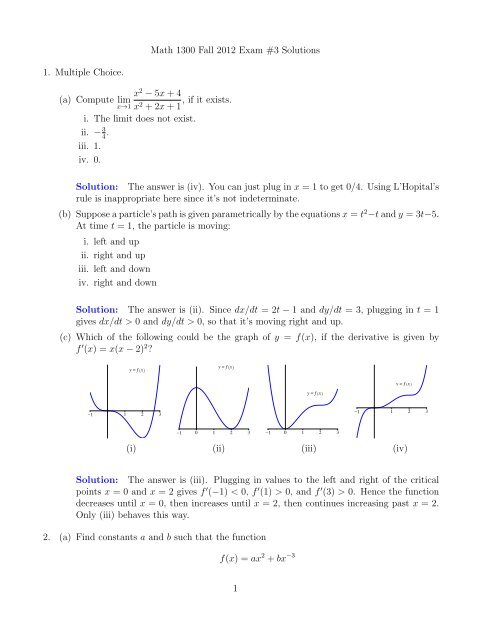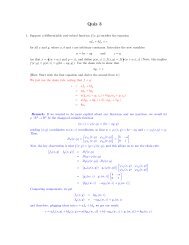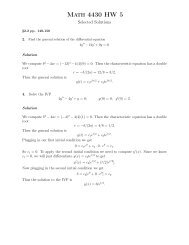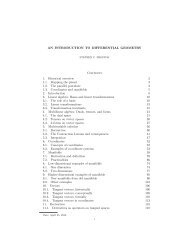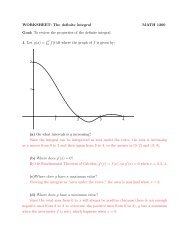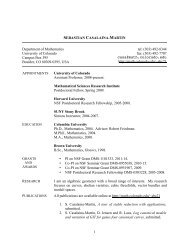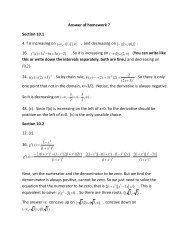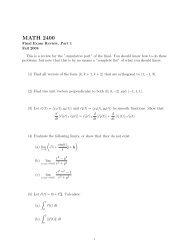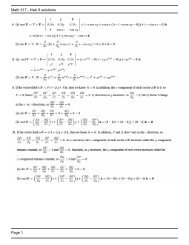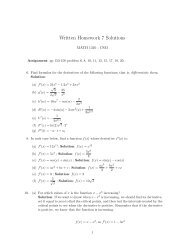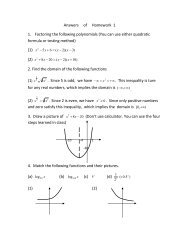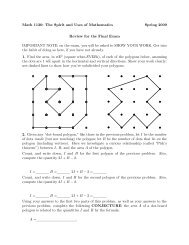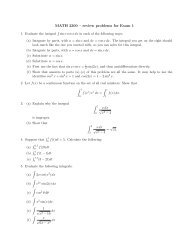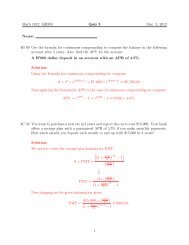Math 1300 Fall 2012 Exam #3 Solutions 1. Multiple Choice. (a ...
Math 1300 Fall 2012 Exam #3 Solutions 1. Multiple Choice. (a ...
Math 1300 Fall 2012 Exam #3 Solutions 1. Multiple Choice. (a ...
Create successful ePaper yourself
Turn your PDF publications into a flip-book with our unique Google optimized e-Paper software.
<strong>1.</strong> <strong>Multiple</strong> <strong>Choice</strong>.<br />
x<br />
(a) Compute lim<br />
x→1<br />
2 − 5x + 4<br />
x2 , if it exists.<br />
+ 2x + 1<br />
i. The limit does not exist.<br />
ii. − 3<br />
4 .<br />
iii. <strong>1.</strong><br />
iv. 0.<br />
<strong>Math</strong> <strong>1300</strong> <strong>Fall</strong> <strong>2012</strong> <strong>Exam</strong> <strong>#3</strong> <strong>Solutions</strong><br />
Solution: The answer is (iv). You can just plug in x = 1 to get 0/4. Using L’Hopital’s<br />
rule is inappropriate here since it’s not indeterminate.<br />
(b) Suppose a particle’s path is given parametrically by the equations x = t 2 −t and y = 3t−5.<br />
At time t = 1, the particle is moving:<br />
i. left and up<br />
ii. right and up<br />
iii. left and down<br />
iv. right and down<br />
Solution: The answer is (ii). Since dx/dt = 2t − 1 and dy/dt = 3, plugging in t = 1<br />
gives dx/dt > 0 and dy/dt > 0, so that it’s moving right and up.<br />
(c) Which of the following could be the graph of y = f(x), if the derivative is given by<br />
f ′ (x) = x(x − 2) 2 ?<br />
(i) (ii) (iii) (iv)<br />
Solution: The answer is (iii). Plugging in values to the left and right of the critical<br />
points x = 0 and x = 2 gives f ′ (−1) < 0, f ′ (1) > 0, and f ′ (3) > 0. Hence the function<br />
decreases until x = 0, then increases until x = 2, then continues increasing past x = 2.<br />
Only (iii) behaves this way.<br />
2. (a) Find constants a and b such that the function<br />
f(x) = ax 2 + bx −3<br />
1
has a critical point at (1, 5).<br />
Solution: We have f(1) = 5, so we get the equation<br />
a + b = 5.<br />
Also the fact that there is a critical point at x = 1 means that f ′ (1) = 0. Since<br />
we end up with<br />
f ′ (x) = 2ax − 3bx −4 ,<br />
f ′ (1) = 2a − 3b = 0.<br />
That means a = 3b,<br />
and plugging into the first equation gives us<br />
2<br />
3b<br />
+ b = 5,<br />
2<br />
which means 5b<br />
= 5, or b = 2. Then solving gives a = 3.<br />
2<br />
So the function is<br />
f(x) = 3x 2 + 2x −3 .<br />
(b) For these values of a and b, is the critical point a local minimum, a local maximum, or<br />
neither?<br />
Solution: It’s a local minimum.<br />
There are three ways to see this.<br />
• Use the First Derivative Test. f ′ (x) = 6x − 6x−4 , so f ′ ( 1)<br />
= 3 − 96 < 0 and<br />
2<br />
f ′ (2) = 12 − 6 > 0. 16<br />
• Use the Second Derivative Test. f ′′ (x) = 6 + 24x−5 , so that f ′′ (1) = 30 > 0.<br />
• Use the fact that f(x) → ∞ as x → 0 and as x → ∞. That means the function<br />
cannot have a global maximum but must have a global minimum at the critical<br />
point, which must therefore also be a local minimum.<br />
3. (a) Find the tangent line to the curve 2x 2 + y 3 = 5x 3 y at the point (1, 2).<br />
Solution: Differentiate implicitly.<br />
2 dy<br />
4x + 3y<br />
dx = 15x2 3 dy<br />
y + 5x<br />
dx<br />
4x − 15x 2 y = (5x 3 − 3y 2 ) dy<br />
dx<br />
dy<br />
dx = 4x − 15x2y 5x3 .<br />
− 3y2 At x = 1 and y = 2, we get<br />
dy 4 − 30<br />
=<br />
dx 5 − 12<br />
This is the slope, so the tangent line is<br />
= 26<br />
7 .<br />
y = 2 + 26(x<br />
− 1).<br />
7<br />
2
(b) Use the tangent line from part (a) to estimate y when x = <strong>1.</strong>2.<br />
Solution: When x = <strong>1.</strong>2, we have<br />
4. For the function<br />
y ≈ 2 + 26<br />
7<br />
f(x) = x2 + 8<br />
x + 1<br />
· 0.2 = 96<br />
35 .<br />
on the interval [0, 5], find the global maximum and global minimum.<br />
Solution: We just have to find the critical points. Compute using the Quotient Rule:<br />
f ′ (x) = (x + 1)(2x) − (x2 + 8)(1)<br />
(x + 1) 2<br />
= 2x2 + 2x − x 2 − 8<br />
(x + 1) 2<br />
= x2 + 2x − 8<br />
(x + 1) 2<br />
= (x + 4)(x − 2)<br />
(x + 1) 2 .<br />
Critical points are where the derivative is zero or does not exist; this happens at x = −4,<br />
x = 2, and x = −<strong>1.</strong> However only x = 2 matters because our interval is [0, 5].<br />
We finally check f(2), f(0), and f(5). We get<br />
f(2) = 12<br />
3<br />
= 4, f(0) = 8, f(5) = 33<br />
6<br />
= 5.5.<br />
So the global maximum occurs at x = 0 and the global minimum occurs at x = 2.<br />
5. (a) State precisely the Mean Value Theorem.<br />
Solution: If f is continuous on [a, b] and differentiable everywhere on (a, b), then there<br />
is a number c such that a < c < b and<br />
f ′ (c) =<br />
f(b) − f(a)<br />
.<br />
b − a<br />
(b) Does the function f(x) = √ x satisfy the hypotheses of the Mean Value Theorem on the<br />
interval [0, 4]?<br />
Solution: Yes. It is continuous on [0, 4], and although it is not differentiable at x = 0,<br />
it is differentiable for x > 0.<br />
3
(c) Show that the function f(x) = √ x satisfies the conclusion of the Mean Value Theorem<br />
on [0, 4] by finding the value c.<br />
Solution: The slope of the secant line is<br />
√ √<br />
f(b) − f(a) 4 − 0<br />
=<br />
b − a 4 − 0<br />
On the other hand we have f ′ (x) = 1<br />
2 x−1/2 , so that<br />
= 2<br />
4<br />
f ′ f(b) − f(a)<br />
(c) =<br />
b − a<br />
1<br />
2 c−1/2 = 1<br />
2<br />
c −1/2 = 1<br />
c = <strong>1.</strong><br />
= 1<br />
2 .<br />
6. Suppose you want to use 24 feet of fencing to enclose three separate square-shaped regions,<br />
one which has side length x and the other two which each have side length y.<br />
(a) Draw a picture of the situation, with labels.<br />
Solution: I had in mind Bizarro Mickey Mouse.<br />
(b) Find a formula for x in terms of y.<br />
Solution: The total perimeter must be 4x + 4y + 4y = 24, which means x = 6 − 2y.<br />
(c) What is the largest y can be? What is the smallest it can be?<br />
Solution: The largest y could be is if x is (close to) 0, which means y = 3. The smallest<br />
y can be is 0.<br />
(d) Find a formula for the total area A in terms of y.<br />
Solution:<br />
A = x 2 + 2y 2 = 2y 2 + (6 − 2y) 2 .<br />
4
7.<br />
(e) What choice of y maximizes this area?<br />
Solution: The critical point occurs when A ′ (y) = 0, so that<br />
4y − 4(6 − 2y) = 0,<br />
which implies that 12y = 24 or y = 2.<br />
Plugging in the critical point and the two endpoints gives<br />
A(0) = 36, A(2) = 8 + 4 = 12, A(3) = 18.<br />
Hence the area is maximized when y = 0, i.e., all the fencing goes around one big square.<br />
(f) What is x for the choice of y in part (e)?<br />
Solution: When y = 0, we have x = 6 feet.<br />
A lazy dog-owner has set up a laser pointer, four<br />
feet from the nearest wall, to rotate at constant<br />
speed of dθ/dt = 10 radians per minute, so that<br />
the dog will chase the dot projected on the wall<br />
around the room while the owner watches Star<br />
Wars movies.<br />
How fast is the dot moving along the wall when<br />
its distance from the closest point on the wall is<br />
x = 4 feet? (You do not need to simplify.)<br />
Solution: The relationship between x and θ is, using the TOA part of SOH-CAH-TOA,<br />
x<br />
4<br />
= tan θ,<br />
or x = 4 tan θ. Differentiating both sides with respect to time, we get<br />
Now at the time we care about, θ = arctan 4<br />
4<br />
dx<br />
dt = 4 sec2 θ dθ<br />
dt .<br />
π<br />
= arctan 1 = , and thus<br />
4<br />
dx<br />
dt = 4 · sec2 (π/4) · 10 = 80 feet per minute.<br />
5


